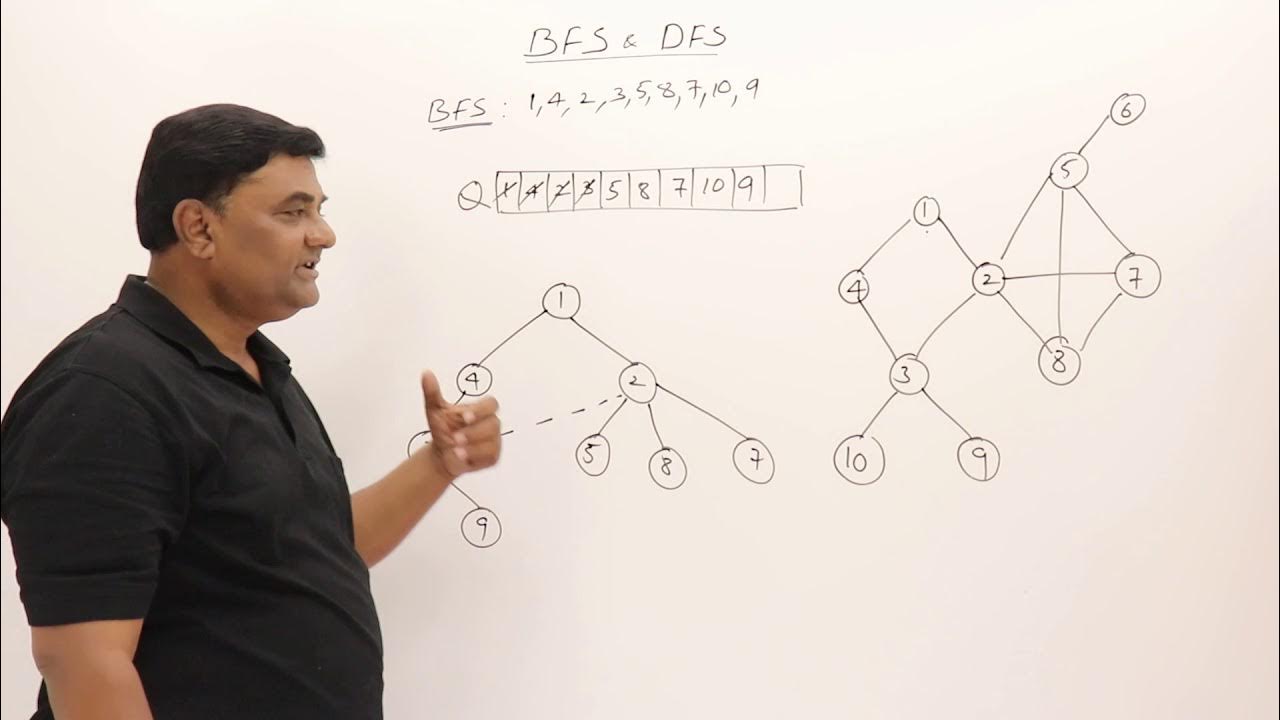93. OCR A Level (H446) SLR14 - 1.4 Data structures part 2 - Graphs (operations)
Summary
TLDRThis video explores graph data structures, focusing on how to traverse, add, and remove items. It introduces graph traversal methods such as breadth-first and depth-first search, explaining their algorithms and differences. The video covers the importance of efficient algorithms to add and remove nodes in a graph, including the use of arrays, object-oriented techniques, and recursion. It also highlights the challenges of mastering data structures and algorithms, and encourages hands-on practice. Additionally, the video promotes a book on essential algorithms, offering a comprehensive guide to data structures, including pseudocode and coding examples in Python and VB.
Takeaways
- 😀 Graphs are versatile data structures with various applications, where nodes can be connected in many ways.
- 😀 There isn't a single algorithm for adding or removing items from a graph as it depends on the graph structure and the situation.
- 😀 Efficient algorithms for graph traversal are essential for adding or removing items, with BFS and DFS being two popular methods.
- 😀 Binary trees are a special type of graph, and they have specific algorithms for adding or removing items.
- 😀 A breadth-first search (BFS) uses a queue and explores nodes level by level, ensuring the shortest path is found.
- 😀 In BFS, nodes are visited in the order they are dequeued from the front of the queue, with unvisited nodes enqueued for later exploration.
- 😀 A depth-first search (DFS) uses a stack and explores nodes by diving deeper into the graph before backtracking.
- 😀 In DFS, nodes are pushed onto the stack and popped off when visited, following a 'last in, first out' approach.
- 😀 DFS may produce different valid outputs depending on the order in which nodes are visited, but it's always a valid traversal.
- 😀 Both BFS and DFS can be implemented iteratively or recursively, with recursion simplifying the DFS algorithm in particular.
- 😀 Understanding the differences between BFS and DFS, as well as how to implement these algorithms, is crucial for working with graph data structures.
Q & A
What is the main focus of this video?
-This video focuses on graph data structures, specifically how to traverse a graph, add items to it, and remove items from it. It also covers two common traversal algorithms: breadth-first search (BFS) and depth-first search (DFS).
Why can't there be a single algorithm for adding or removing items from a graph?
-There is no single algorithm for adding or removing items from a graph because graphs can have various structures and configurations. The method used depends on the type of graph and the item being added or removed.
What is the importance of traversal algorithms in the context of graph operations?
-Traversal algorithms are crucial because they help efficiently navigate the graph to locate specific nodes. These algorithms allow us to add or remove items by ensuring we can reach the desired node or connection in the graph.
What is the difference between breadth-first search (BFS) and depth-first search (DFS)?
-BFS explores the graph level by level, using a queue, and is ideal for finding the shortest path between nodes. DFS, on the other hand, explores as deep as possible along one branch before backtracking, using a stack, and can be implemented iteratively or recursively.
How does a breadth-first search (BFS) algorithm work?
-BFS starts at the root node, marks it as visited, and enqueues its adjacent nodes. It then processes the nodes in the queue one at a time, visiting each unvisited adjacent node, and repeats this process until all nodes have been visited.
What data structure is used in BFS, and why is it suited for this algorithm?
-BFS uses a queue, which follows the First-In, First-Out (FIFO) principle. This is ideal for BFS because it ensures that nodes are visited in the order they were discovered, level by level.
How does depth-first search (DFS) differ in traversal from BFS?
-DFS uses a stack (Last-In, First-Out or LIFO) to explore as deeply as possible along one path before backtracking. Unlike BFS, which explores all nodes level by level, DFS dives deep into each branch of the graph before visiting other branches.
What is the role of recursion in DFS, and how does it simplify the algorithm?
-Recursion simplifies the DFS algorithm by automatically handling the stack operations. Each recursive call pushes the current node onto the stack and processes it, eliminating the need to manually manage a stack data structure.
What are the key differences between the results of BFS and DFS on the same graph?
-BFS explores the graph level by level and tends to visit nodes in a more ordered, shortest-path manner. DFS, depending on its implementation, may visit nodes in a different order, exploring one branch fully before backtracking. Both algorithms produce valid traversal results but in different sequences.
What resources are suggested for further practice and learning about graph algorithms?
-The video recommends the book 'Essential Algorithms for A-Level Computer Science,' which covers all data structures and algorithms, including graph operations, with practical examples and coding implementations in Python and VB.
Outlines

此内容仅限付费用户访问。 请升级后访问。
立即升级Mindmap

此内容仅限付费用户访问。 请升级后访问。
立即升级Keywords

此内容仅限付费用户访问。 请升级后访问。
立即升级Highlights

此内容仅限付费用户访问。 请升级后访问。
立即升级Transcripts

此内容仅限付费用户访问。 请升级后访问。
立即升级浏览更多相关视频

94. OCR A Level (H046-H446) SLR14 - 1.4 Data structures part 3 - Stacks & queues (operations)

92. OCR A Level (H446) SLR14 - 1.4 Data structures part 1 - Linked lists (operations)

5.1 Graph Traversals - BFS & DFS -Breadth First Search and Depth First Search

10. INF-ED | Lista doblemente enlazada: explicación de la estructura de datos.

RANGKUMAN BAB 2 - INFORMATIKA KELAS 9 - STRUKTUR DATA MODEL GRAPH AND TREE

#9 Konsep Struktur Data Graph pada Pemrograman | STRUKTUR DATA
5.0 / 5 (0 votes)
